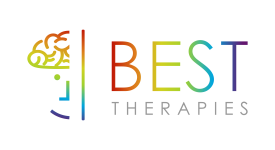Article At Glance:
- The emotional wheel shows eight core emotions (joy, sadness, anger, fear, etc.) and their subtle variations visually.
- It helps increase self-awareness by allowing you to identify and differentiate the emotions you’re feeling precisely.
- Therapists use the wheel to assist clients in understanding emotions, recognizing triggers, and creating coping strategies.
Do you wish you had a tool that helps you identify what you’re feeling? You can use a tool called the emotional wheel to create awareness of your feelings and teach you to control your behaviors.
Keep reading to discover what you can gain from an emotions wheel and where you can find help using it to improve self-awareness and tap into your emotions.
Emotions: Universal and Otherwise

Every person experiences emotions and the feelings they cause. Emotions are a part of life you can’t escape and shouldn’t ignore. Emotions are universal and break down into eight primary emotions: sadness, joy, anger, fear, trust, surprise, disgust, and anticipation.
However, although we all share the same basic emotions, we don’t react the same way. Our emotional responses, also known as our feelings, are individual and situational.
What Is the Emotional Wheel?
The Putchik Wheel is the most common version of the emotional wheel, named after the psychologist who invented it in the 1980s. It takes the form of a flower, with each of the eight core emotions a different petal.
The emotion wheel includes sections for the eight universal emotions: sadness, joy, anger, fear, trust, surprise, disgust, and anticipation.
It orients the more intense emotions toward the center of the wheel, while the lighter secondary emotions are toward the outer layer.
How It’s Structured and What Each Section Represents

Therapists use different types of emotion wheels, but they all share the same basic structure.
Multiple Colors
On an emotional wheel, a different color represents each core emotion. Red usually symbolizes anger, while yellow shows happiness. The darker the shade, the more intense the emotion.
If you’re feeling happy, look at the yellow section of the wheel. If you’re content, the shade is a pale yellow. If you’re feeling excited, you see a bright lemon yellow.
Layers
At the center of the wheel are the core emotions. The second (middle) layer consists of less-intense expressions of the core emotion. The outside layer contains the most nuanced feelings.
If you’re angry, find the emotion in the center of the wheel. From there, you move to the middle layer of anger with options such as mad, aggressive, or distant.
Relations
The emotions on the wheel relate two each other in two ways:
- The outer emotions flow directly from the inner ones. You don’t see the feeling of curiosity flowing from the secondary emotion of acceptance, even though they both share the core emotion of happiness.
- Emotions directly opposite each other are contrary emotions: Anger is the opposite of happiness.
The Power of Using the Emotional Wheel
When you discover how to use the feeling wheel, you’ll find two primary improvements in your life.
Emotional Wheel for Greater Self-Awareness
- Identify feelings in a nuanced way you might not have words for. If you’re feeling frustrated but can’t quite decide if you’re infuriated or annoyed, the wheel helps.
- Pause and reflect when you’re overwhelmed. The visual aid helps interrupt the feeling as your brain remembers to take time for identification.
- Identify deeper emotions. If you use the wheel enough, eventually, you’ll know your precise emotion without looking at the wheel.
Emotional Wheel for Improved Emotional Intelligence
Emotional intelligence is more than awareness. High emotional intelligence means you can both identify and regulate (control) your emotions.
To increase your emotional intelligence, use the following steps:
- Name your emotion. Spend some time considering how you feel and go through the options on the wheel. When you name your emotions, you can identify their triggers.
- Reflect on the emotion’s cause. Your feelings might result from something that happened a day, week, or month ago. A therapist can help you develop methods for identifying your emotion’s causes.
- Choose a behavior. You can choose to confront the cause, learn to avoid it, or change your habits to change your emotional reaction to a trigger in the future.
Additional Read: Feeling Emotionally Numb: Signs, Symptoms & Strategies
An Example of the Emotional Wheel in Action
Therapists use the emotional wheel to help you identify and understand your emotions. You can take out the emotion wheel, look at the different emotions, and find the ones that resonate with your feelings.
Now that you’ve named the emotions, you can backtrack to identify what triggered those emotions. You can change your routine to avoid the trigger or find a way to change your reaction.
Once you understand how the wheel works, you can use it daily to achieve greater emotional intelligence.
The Bottom Line
The emotional wheel is a valuable tool. The qualified therapists at Best Therapies can help you harness the power of the wheel in your everyday life. Contact us to book an appointment today.


